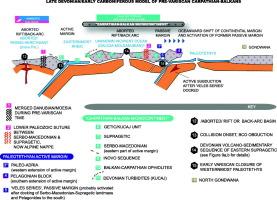Reconstruction of the enigmatic pre-Variscan paleogeographic configuration of the western peri-Moesian realm (Carpathian-Balkans, eastern Serbia): An insight into Devonian small-scale continental and paleo-oceanic units
IF 10
1区 地球科学
Q1 GEOSCIENCES, MULTIDISCIPLINARY
引用次数: 0
Abstract
The Carpathian-Balkans provide insight into how two distinct but limited-sized north Gondwanan ribbon-shaped paleocontinents interacted prior to the Variscan Devonian collisional onset: (i) the drifted “Carpathian-Balkan microcontinent” (Serbo-Macedonian/Supragetic/Getic(Kučaj)) and (ii) the already amalgamated Avalonian Danubian-Moesian basement fragment with its Devonian suture elements. These two crustal fragments were separated by the intervening Rheic Ocean during the Devonian. Despite the investigated eastern Variscan collisional assembly being stacked near the overprinted promontory of the East European Craton, its sliced basement segments and their Devonian record are well exposed in eastern Serbia. The synthesis reveals that the sliced Carpathian-Balkan inliers play a crucial role in understanding the lithospheric-scale movement of smaller continental terranes from north Gondwana and their suturing modes related to the surrounding Paleozoic oceans. An analysis of geochemical, paleogeographic, and regional geological data reveals that continental and oceanic paleoenvironments existed prior to and during the Devonian period, merging with the already amalgamated Danubian block and the Moesian microplate. Nonetheless, despite the well-preserved Devonian record found in eastern Serbia, the Romanian South Carpathians, and western Bulgaria, only a limited number of reconstructions clarify the pre-Variscan tectono-paleogeographic setting.
After a few rift-drift cycles connecting north Gondwana and southern Laurussia, the tectonic transport of Cadomian to Cenerian peripheral terranes from northern Gondwana begun with the post-Ordovician rifting off. The rifting led to the formation of narrow, elongated crustal segments. The outboard Lower Paleozoic ribbon-shaped paleocontinent, including its Carpathian-Balkan continental fragment, occupied a position between two principal Paleozoic oceans. On the southern flank of the exotic narrow Lower Paleozoic microcontinent, we demonstrate for the first time the presence of a continental extension of Devonian age, likely associated with the adjacent Paleotethyan Ocean. The synthesis further demonstrates that the volcano-sedimentary protoliths of Devonian-aged greenschist facies rocks, which traverse the continental Serbo-Macedonian/Supragetic/Getic Devonian microcontinent, serve as markers of Early Devonian (back-arc) rifting. On its opposite Eurasian flank towards Danubian/Moesia, following the accumulation of Silurian–Early Devonian deep-water sediments, the Kučaj(Getic) turbidites, along with the expanding Middle to Late Devonian oceanic crust (Danubian ophiolites), belonged to the Rheic Ocean. The geochemical modeling of Devonian ophiolites reveals that this Balkan-Carpathian ocean displays both mid-ocean ridge basaltic (Tisoviţa Iuţi, Deli Jovan) and volcanic arc/back-arc signatures (Zaglavak, Tcherni Vrah). The extracted petrographic and regional geological constraints confirm the short transport of eroded material from the eroded Serbo-Macedonian/Supragetic narrow elongated landmass into the Late Devonian (Carboniferous) Kučaj(Getic) trench turbidites. Geochemical signatures outline the intraoceanic character of this frontal pre-Variscan subduction-driven active margin. The proposed new Devonian reconstruction updates the existing paleogeographic constraints on the opposite Avalonian block, revealing that the narrow Devonian ocean and its subduction beneath the Avalonian “micro-terranes” (Danubian/Moesia) produced an epicontinental basin with Devonian volcanism assigned to the Hanseatic-type rifting off processes.

重建神秘的前variscan古地理构造的西部围moesian领域(喀尔巴阡-巴尔干半岛,塞尔维亚东部):对泥盆纪小尺度大陆和古海洋单元的洞察
喀尔巴阡-巴尔干提供了两个不同但规模有限的北冈瓦纳带状古大陆在瓦里斯坎泥盆纪碰撞开始之前是如何相互作用的见解:(i)漂移的“喀尔巴阡-巴尔干微大陆”(塞尔维亚-马其顿/上陆/地陆(ku aj))和(ii)已经合并的阿瓦洛尼亚-多瑙河-莫西亚基底碎片及其泥盆纪的接合元素。这两个地壳碎片在泥盆纪被介入的里海分隔开。尽管所调查的东方济各碰撞组合堆积在东欧克拉通叠印海角附近,但其切割基底段及其泥盆世记录在塞尔维亚东部得到了很好的暴露。综合结果表明,喀尔巴阡-巴尔干断层对了解冈瓦纳北部较小大陆块体的岩石圈尺度运动及其与周围古生代海洋的缝合模式具有重要意义。地球化学、古地理和区域地质资料分析表明,在泥盆纪之前和泥盆纪期间存在大陆和海洋古环境,并与已经合并的多瑙河地块和莫伊斯微板块相融合。然而,尽管在塞尔维亚东部、罗马尼亚南喀尔巴阡山脉和保加利亚西部发现了保存完好的泥盆纪记录,但只有有限数量的重建阐明了前瓦里斯坎构造-古地理环境。经过几次连接冈瓦纳北部和俄罗斯南部的裂谷-漂移旋回后,冈瓦纳北部的卡多米亚系到切涅尔系外围地体的构造搬运开始于后奥陶世的裂谷断裂。裂谷作用导致了狭长的地壳段的形成。下古生代外带状古大陆,包括其喀尔巴阡-巴尔干大陆碎片,位于两个古生代主要海洋之间。在奇异的下古生代狭窄微大陆的南侧,我们首次证明了泥盆纪时代大陆伸展的存在,可能与邻近的古特提斯洋有关。综合研究进一步表明,穿越塞尔维亚-马其顿/上陆/古泥盆世微大陆的泥盆世绿片岩相火山岩沉积原岩是早泥盆世(弧后)裂陷的标志。在朝向多瑙河/Moesia的欧亚侧,随着志留纪-早泥盆世深水沉积物的堆积,ku(动态)浊积岩与扩张的中-晚泥盆世海洋地壳(多瑙河蛇绿岩)一起属于Rheic洋。泥盆纪蛇绿岩地球化学模拟表明,该巴尔干-喀尔巴阡海具有洋中脊玄武岩(Tisoviţa Iuţi, Deli Jovan)和火山弧/弧后特征(Zaglavak, Tcherni Vrah)。提取的岩石学和区域地质约束条件证实了侵蚀物质从被侵蚀的塞尔维亚-马其顿/上陆狭窄拉长的陆块向晚泥盆世(石炭世)ku aj(沉积层)沟浊积岩的短暂搬运。地球化学特征勾勒出该锋面前瓦里斯坎俯冲驱动活动边缘的洋内特征。新的泥盆纪重建更新了对侧阿瓦洛尼亚地块现有的古地理约束,揭示了狭窄的泥盆纪海洋及其在阿瓦洛尼亚“微地体”(Danubian/Moesia)下的俯冲形成了一个陆表盆地,泥盆纪火山作用属于汉塞式裂离过程。
本文章由计算机程序翻译,如有差异,请以英文原文为准。
求助全文
约1分钟内获得全文
求助全文
来源期刊

Earth-Science Reviews
地学-地球科学综合
CiteScore
21.70
自引率
5.80%
发文量
294
审稿时长
15.1 weeks
期刊介绍:
Covering a much wider field than the usual specialist journals, Earth Science Reviews publishes review articles dealing with all aspects of Earth Sciences, and is an important vehicle for allowing readers to see their particular interest related to the Earth Sciences as a whole.
 求助内容:
求助内容: 应助结果提醒方式:
应助结果提醒方式:


